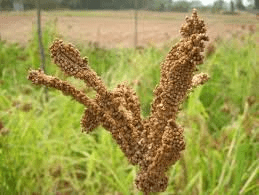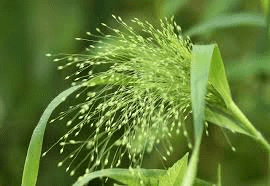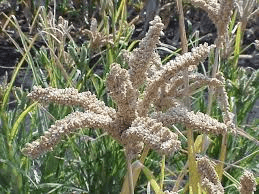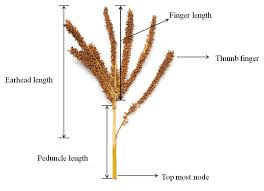The millet panicle is a crucial botanical structure in millet plants, serving as the arrangement where spikelets, which house the flowers and seeds, are organized. This structure plays a significant role in the reproductive success and yield of millet crops. Understanding the millet panicle’s characteristics can provide insights into its development, agricultural importance, and variations among different millet species.
A panicle is a branched cluster of spikelets, which are the units that contain the flowers and seeds. In millet plants, the panicle is the primary reproductive structure that emerges from the central stem. It consists of a main axis or rachis, from which secondary branches extend. These branches bear the spikelets, and the overall shape and arrangement of the panicle can vary greatly depending on the millet species.
In general, millet panicles are characterized by their branched nature. The main rachis of the panicle may have several lateral branches or pedicels, each bearing one or more spikelets. The spikelets are arranged in a way that maximizes exposure to sunlight and improves access to pollinators. The branching pattern of the panicle can affect the plant’s ability to capture sunlight and nutrients, which are essential for seed development.
Different millet species exhibit a range of panicle forms. For example, in pearl millet (Pennisetum glaucum), the panicle is often cylindrical or elongated, with densely packed spikelets. This form helps in the efficient collection of rainwater and provides better seed protection. In contrast, finger millet (Eleusine coracana) has a more compact and dense panicle, with spikelets grouped closely together. This structure helps in optimizing space and improving the plant’s resistance to environmental stressors.
The panicle’s development is influenced by various factors, including environmental conditions, genetics, and cultivation practices. Temperature, humidity, and soil conditions play a role in determining the size, shape, and density of the panicle. Additionally, breeding programs often focus on panicle traits to enhance millet varieties for better yield, disease resistance, and adaptability to different climates.
The panicle’s role in reproduction is vital. During flowering, the spikelets within the panicle release pollen, which is transferred to the pistils of other spikelets, leading to fertilization. This process results in the formation of seeds, which are subsequently harvested as millet grain. The arrangement of spikelets within the panicle helps ensure efficient pollination and seed development.
The millet panicle is a key reproductive structure in millet plants, consisting of a central rachis and branching spikelets. Its form and structure vary among different millet species and significantly impact the plant’s reproductive success and yield. Understanding the characteristics and development of the millet panicle is essential for improving agricultural practices and enhancing millet crop production.
The Economic Importance and Uses of Millet Panicle

1. Grain Production: The millet panicle is the flowering and seed-bearing part of the millet plant, essential for the production of millet grains.
2. Crop Yield: The panicle’s structure and density affect the overall yield of millet crops, influencing the amount of harvestable grain.
3. Seed Collection: The panicle is harvested to collect millet seeds, which are used for human consumption, animal feed, and industrial purposes.
4. Livestock Feed: After harvesting, millet panicles can be used as feed for livestock, providing roughage and additional nutrients.
5. Mulching Material: Millet panicles, when chopped, can be used as mulch to retain soil moisture, suppress weeds, and regulate soil temperature.
6. Compost Ingredient: The panicles can be added to compost piles, where they decompose and contribute to nutrient-rich compost for gardens and farms.
7. Biofuel Production: Millet panicles can be processed into biofuel, such as ethanol, contributing to renewable energy sources.
8. Erosion Control: Used in erosion control practices, millet panicles help stabilize soil and prevent erosion by forming a protective layer on the soil surface.
9. Craft Materials: The panicle can be used in crafting, including making natural decorations, wreaths, or other ornamental items.
10. Soil Amendment: Decomposed millet panicles add organic matter and improve soil health, enhancing soil fertility and structure.
11. Animal Bedding: Dried millet panicles can be used as bedding material for livestock, providing a comfortable and absorbent surface.
12. Carbon Sequestration: Millet panicles contribute to carbon sequestration when used as biomass or incorporated into soil, helping mitigate climate change.
13. Biomass Energy: Millet panicles can be used as biomass for energy production, providing a renewable source of heat and electricity.
14. Traditional Medicine: In some cultures, millet panicles are used in traditional medicine for their purported health benefits.
15. Green Manure: Millet panicles can be used as green manure, adding organic matter and nutrients to the soil when decomposed.
16. Packaging Material: Millet panicles can be used as biodegradable packaging material, offering an eco-friendly alternative to plastic.
17. Soil Fertility Improvement: The decomposition of millet panicles adds valuable nutrients to the soil, enhancing its fertility and promoting healthy plant growth.
18. Educational Uses: Millet panicles can be used in educational settings to teach about plant anatomy, seed formation, and agricultural practices.
Read Also: 19 Medicinal Health Benefits Of Polygonatum biflorum (Solomon’s Seal)
The Products and By-products That Can Be Derived From Millet Panicle

1. Livestock Feed: Millet panicles, after harvesting the grain, are used as roughage in animal feed, providing fiber and nutrients.
2. Mulch: Chopped millet panicles are used as mulch to retain soil moisture, suppress weeds, and regulate soil temperature.
3. Compost: Panicles are added to compost piles, where they decompose and contribute to nutrient-rich compost for gardens and farms.
4. Biofuel: Millet panicles can be processed into biofuel, such as ethanol, contributing to renewable energy sources.
5. Craft Materials: Panicles are used in crafting for making natural decorations, wreaths, and other ornamental items.
6. Soil Amendment: Decomposed panicles improve soil health by adding organic matter and enhancing soil structure and fertility.
7. Animal Bedding: Dried millet panicles are used as bedding material for livestock, providing a comfortable and absorbent surface.
8. Traditional Medicine: In some cultures, millet panicles are used in traditional medicine for their potential health benefits.
9. Erosion Control: Panicles help stabilize soil in erosion control practices by forming a protective layer.
10. Carbon Sequestration: Millet panicles contribute to carbon sequestration when used as biomass or incorporated into soil.
11. Biomass Energy: Panicles are used as biomass for energy production, providing a renewable source of heat and electricity.
12. Green Manure: Panicles are used as green manure to enrich the soil with organic matter and nutrients.
13. Packaging Material: Millet panicles can be used as biodegradable packaging material, offering an eco-friendly alternative to plastic.
14. Soil Fertility: The decomposition of panicles adds valuable nutrients to the soil, enhancing its fertility.
15. Educational Purposes: Panicles can be used in educational settings to demonstrate plant anatomy and agricultural practices.
16. Feed Supplement: Panicles can be included in feed mixes to provide additional fiber and nutrients to livestock diets.
17. Biochar Production: Millet panicles can be converted into biochar, which is used to improve soil health and retain soil moisture.
Read Also: 25 Medicinal Health Benefits Of Astragalus amphioxys (Crescent milkvetch)
Frequently Asked Questions (FAQ’s) About Millet Panicle

1. What is a millet panicle?
A millet panicle is the flowering and seed-bearing part of the millet plant, essential for grain production.
2. How does the panicle affect crop yield?
The structure and density of the panicle influence the overall yield of millet crops by determining the amount of harvestable grain.
3. Can millet panicles be used in animal feed?
Yes, after the grain is harvested, the remaining panicles can be used as roughage in livestock feed.
4. How are panicles used in mulching?
Chopped millet panicles are spread over soil as mulch to retain moisture, suppress weeds, and regulate soil temperature.
5. Are millet panicles suitable for composting?
Yes, millet panicles can be added to compost piles, where they decompose and contribute to nutrient-rich compost.
6. Can panicles be used for biofuel production?
Yes, millet panicles can be processed into biofuel, such as ethanol, which contributes to renewable energy sources.
7. What role do millet panicles play in erosion control?
Panicles help stabilize soil in erosion control practices by forming a protective layer on the soil surface.
8. Can millet panicles be used in crafting?
Yes, millet panicles can be used in crafting for natural decorations, wreaths, and other ornamental items.
9. How do millet panicles benefit soil health?
Decomposed panicles add organic matter to the soil, improving soil fertility and structure.
10. Are millet panicles used in traditional medicine?
In some cultures, millet panicles are used in traditional medicine for their potential health benefits.
Read Also: Principles of Planning in Feasibility Studies and Business Plan






